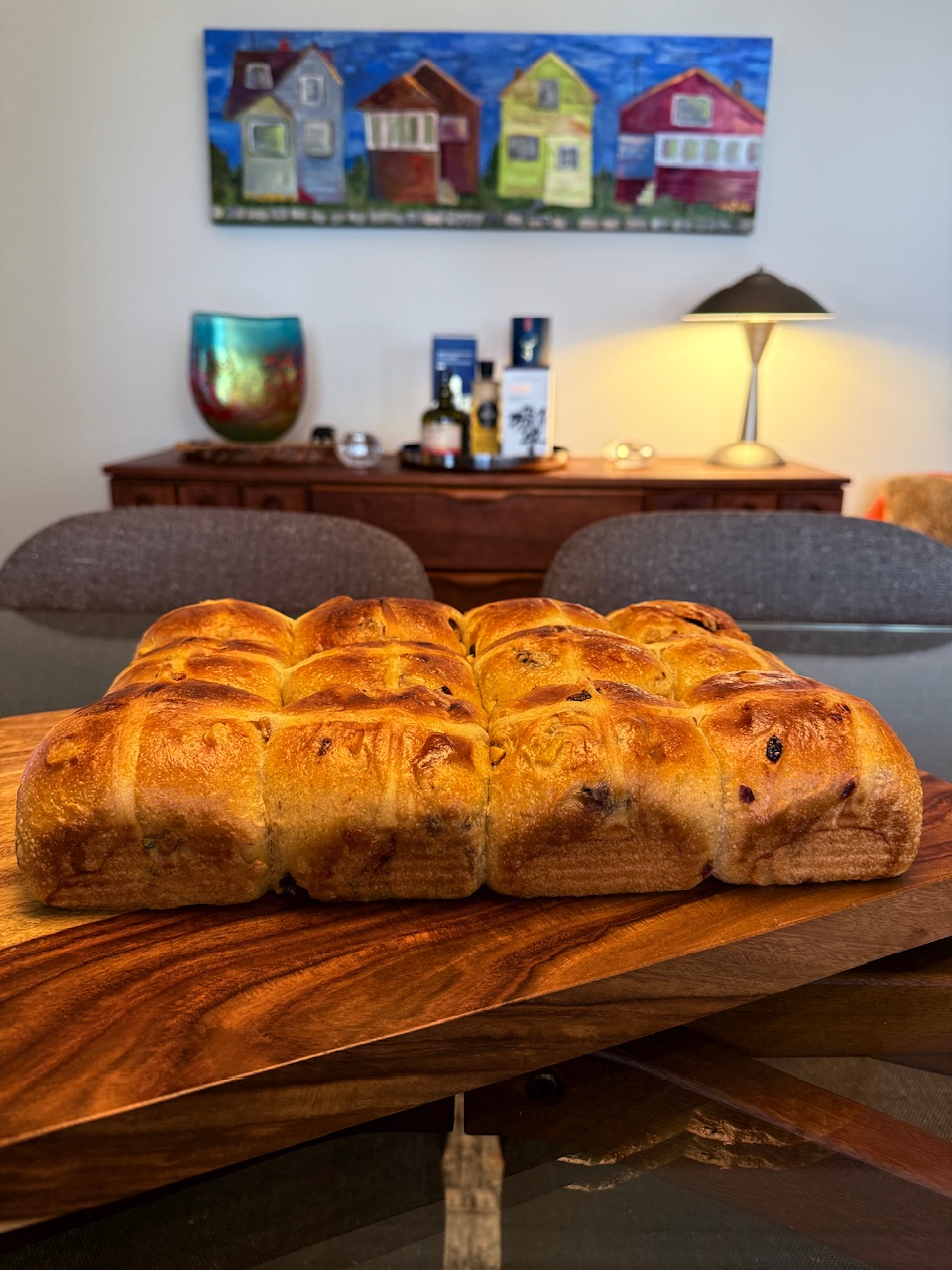
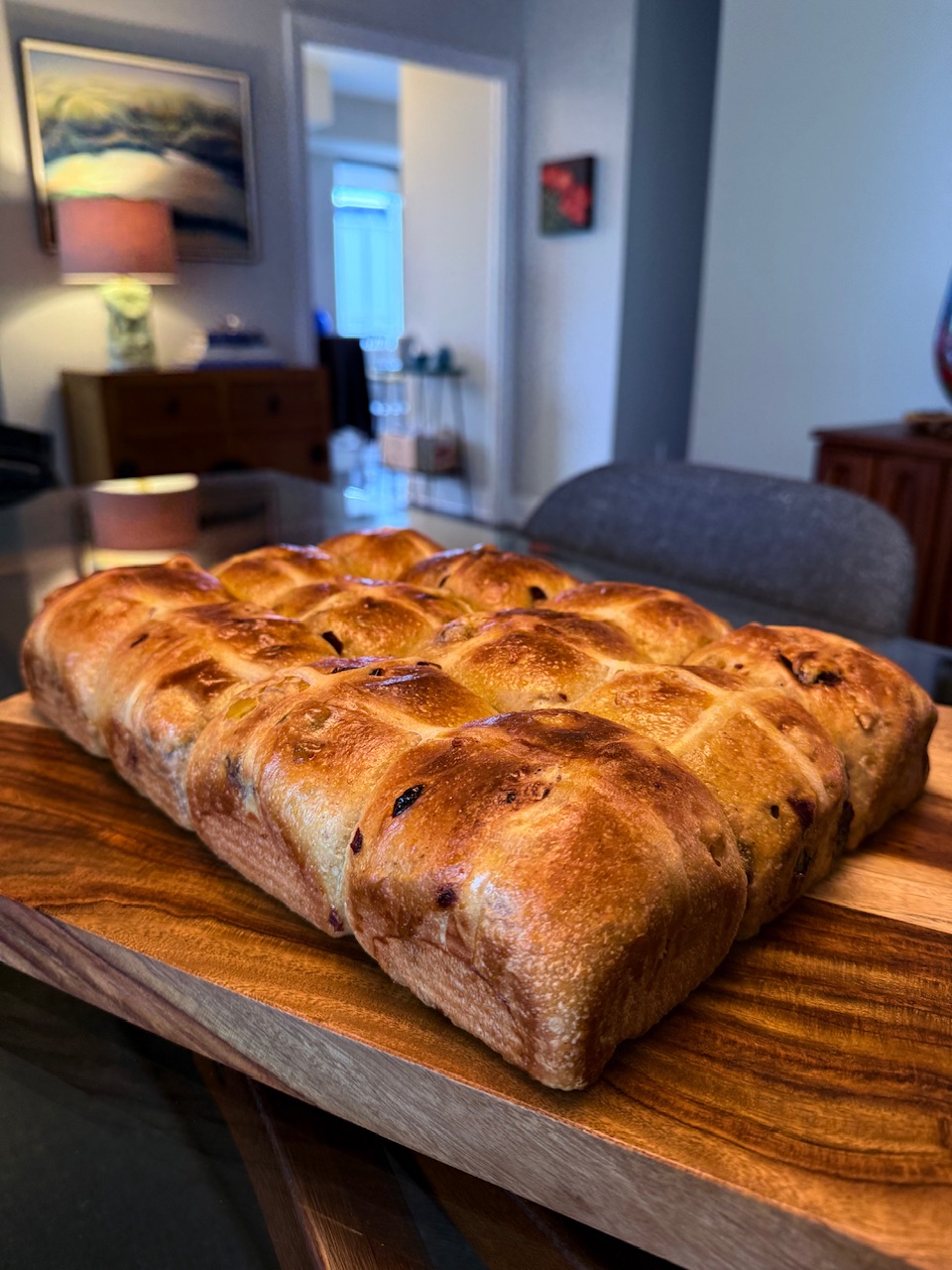
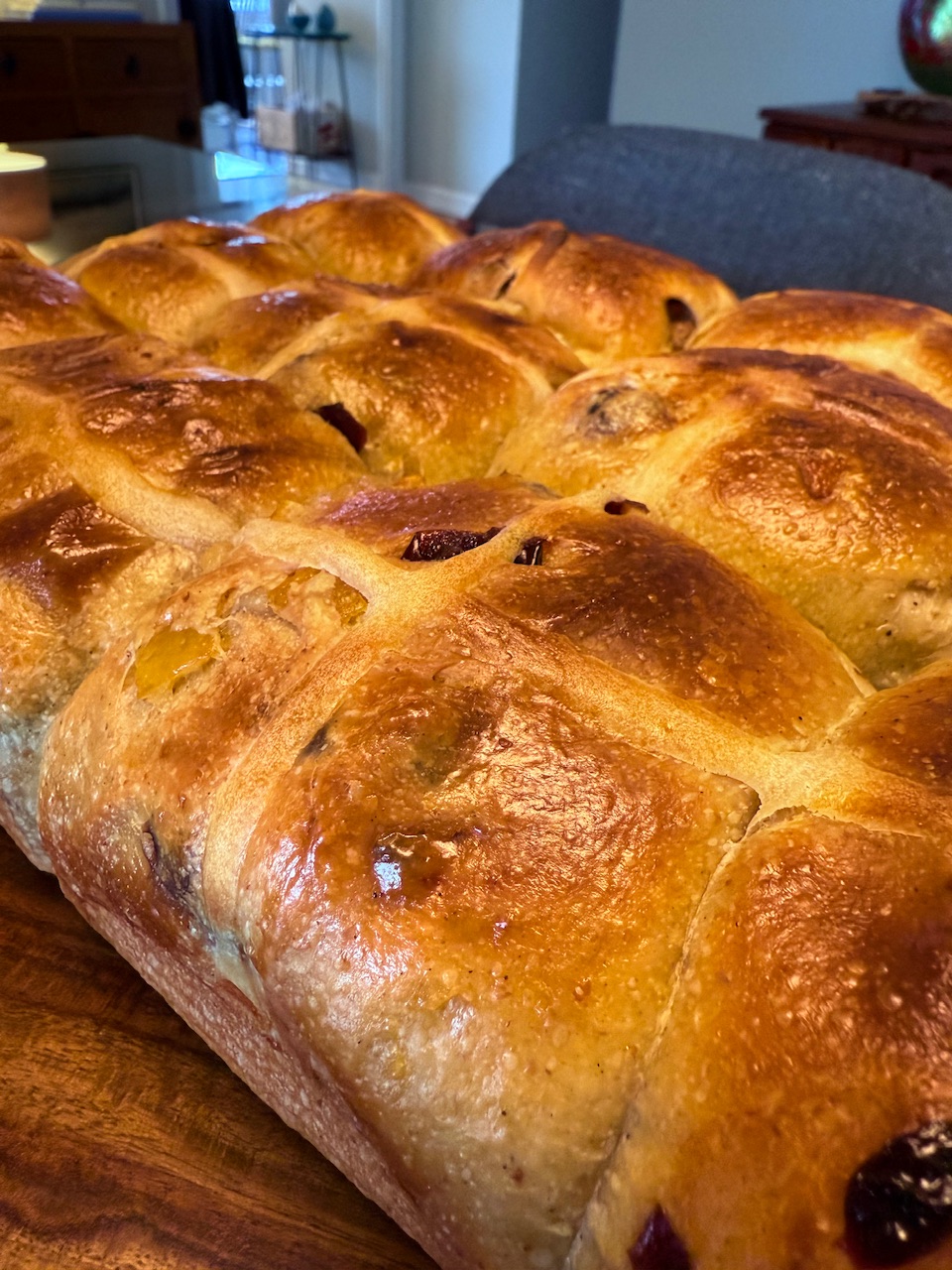

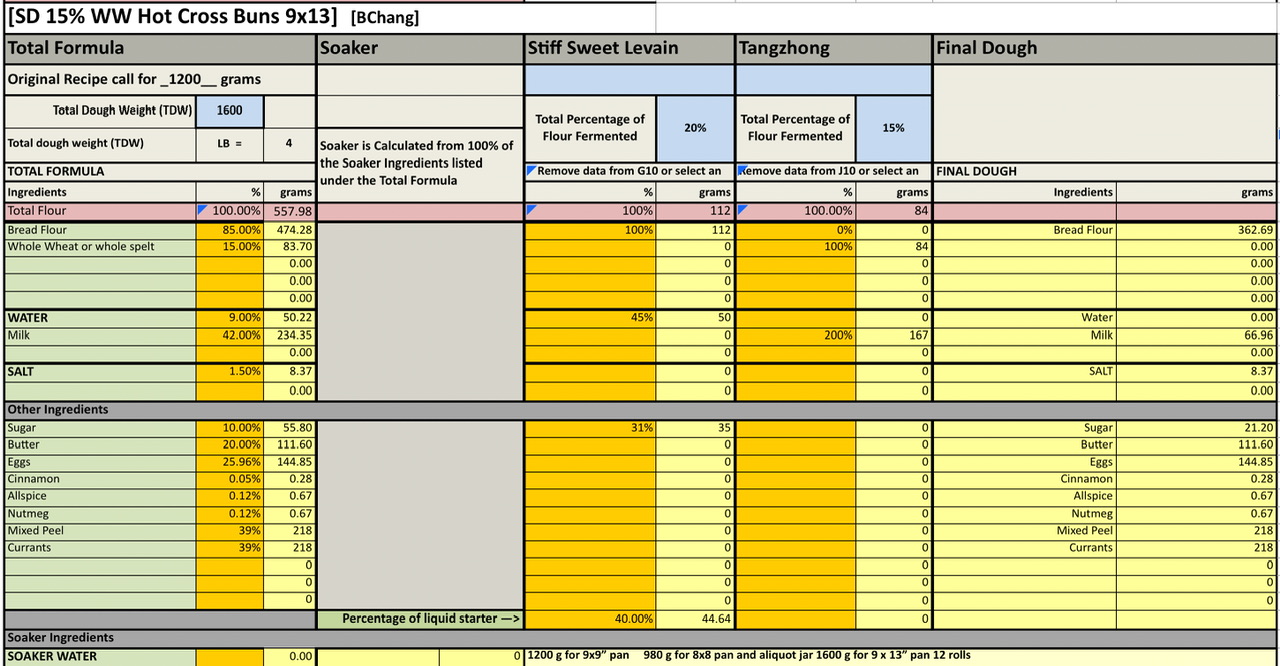
I made more candied lemon peel than I needed for my panettone and didn’t want it to go to waste. Unfortunately the candied orange peel I made months ago had mold growing on it so I didn’t want to have that happen again. Since this was Easter weekend I decided to make these sourdough hot cross buns with 15% whole wheat, candied peel, cranberries and tart cherries. I know that currents or raisins are more traditional but I used what I had. Another note, I didn’t avoid egg washing the crosses and I believe that may have contributed to them browning more than desired. Reducing or eliminating the sugar in the cross paste would also help reduce their browning during baking.
For 12 buns in a 9 x 13” pan
For the crosses
40 g bread flour
10 g sugar
40 g lemon juice
Just prior to baking pipe on crosses with ¼-⅜” piping tip. No egg wash is needed if using the apricot jam to finish.
Instructions
Levain
Mix the levain ingredients in a jar or pyrex container with space for at least 300% growth.
Press down with your knuckles or silicone spatula to create a uniform surface and to push out air.
At a temperature of 78ºF, it typically takes up to 10-12 hours for this sweet stiff levain to be at peak. For my starter I typically see 3-3.5 times increase in size at peak. The levain will smell sweet with only a mild tang.
Tangzhong
In a sauce pan set on medium heat, stir the milk and flour until blended. Then cook for several minutes until well thickened, stirring regularly with a spoon or heat-resistant spatula. Let cool in the pan or, for faster results, in a new bowl. Theoretically it should reach 65ºC (149ºF) but I don’t find I need to measure the temperature as the tangzhong gelatinizes at this temperature. You can prepare this the night before and refrigerate it, ensure that it is covered \to prevent it from drying out.
Dough
Prepare the dried fruit (currants, raisins or blueberries) mist them with water then microwave for 15-30 secs. This will quickly plump them up without them later adding more hydration to your dough.
In the bowl of a stand mixer, add the milk (consider holding back 20 g of milk and adding later if this is the first time you’re making this), egg, tangzhong, salt, sugar, spices and levain. Mix and then break up the levain into many smaller pieces. Next add the flour. I like to use my spatula to mix until there aren’t many dry areas. Allow the flour to hydrate (fermentolyse) for 20-30 minutes. Mix on low speed and then medium speed until moderate gluten development this may take 5-10 mins. You may want to scrape the sides of the bowl during the first 5 minutes of mixing. Next drizzle in the melted butter a little at a time, or alternatively add room temperature butter one pat at a time. Slow the mixer down to avoid splashing the butter at you. The dough may come apart, be patient, continue to mix until it comes together before drizzling or adding in more butter. Once all the butter has been added and incorporated add mixed peel and dried fruit and continue to mix until well incorporated. Increase the speed gradually to medium. Mix at medium speed until the gluten is well developed, approximately 10 mins. You will want to check gluten development by windowpane during this time and stop mixing when you get a good windowpane. You should be able to pull a good windowpane, not quite as good as a white flour because the bran will interrupt the windowpane somewhat.
On the counter, shape the dough into a tight ball, cover in the bowl and ferment for 4-5 hours at 82ºF. There should be some rise visible at this stage.
You can next place the dough into the fridge to chill the dough for about 1.5 hours or overnight (but expect there to be a bit of sour tang if you do a cold retard), this makes rolling the dough easier to shape. Remember, if you do so the final proof will take longer. Alternatively, you can do a cold retard in the fridge overnight, however, you may find that this increases the tang in your bread.
Prepare your pan by greasing it or line with parchment paper. Lightly dust the top of the dough with flour and using a bowl scraper remove the dough from the bowl placing it on the counter. Next divide the dough into 12 equal pieces and shape each into a tight boule. Place each boule into the prepared 9” x 13” pan. Cover and start final proof at 82°F for 2-3 hours, the dough will start to almost fill the pan when final proof is complete and will pass the finger poke test.
Bake
Preheat your oven, with a rack in the lower half, to 350°F (175°C). You should aim to start preheating your oven about 30-40 mins prior to the dough being full proofed. Once your oven is preheated, remove your pan from its bag, and apply the paste in a cross pattern on the buns. Brush with the egg/milk wash avoid egg washing the crosses so they don’t colour. Slide the buns into the oven, and bake for 30 to 35 minutes.
The rolls are finished baking when the tops are well-colored and the internal temperature is around 195°F (90°C). Remove the rolls from the oven and let the rolls cool completely before piping on the lemon icing crosses otherwise the icing will melt if using icing cross. If using flour paste then heat apricot jam in the microwave and brush on the warm buns until they are nicely glazed and shiny (optional)
- Benito's Blog
- Log in or register to post comments
Yum! Looks delicious, Benny
Jay
Thank you Jay, we just devoured two of them and I can say that they were delicious.
Benny
Your baking prowess is amazing. I bet the fragrance was spectacular! Happy Spring.
Thank you Caroline, happy spring to you as well.
Benny
Posted an Easter bread. You win the prize Benny. They look great. I make Hammelmans yeasted version every year but I didn’t want to post them but since no one had I started a post that disappeared before I finished it so now I don’t have to recreate it and will just leave these right here.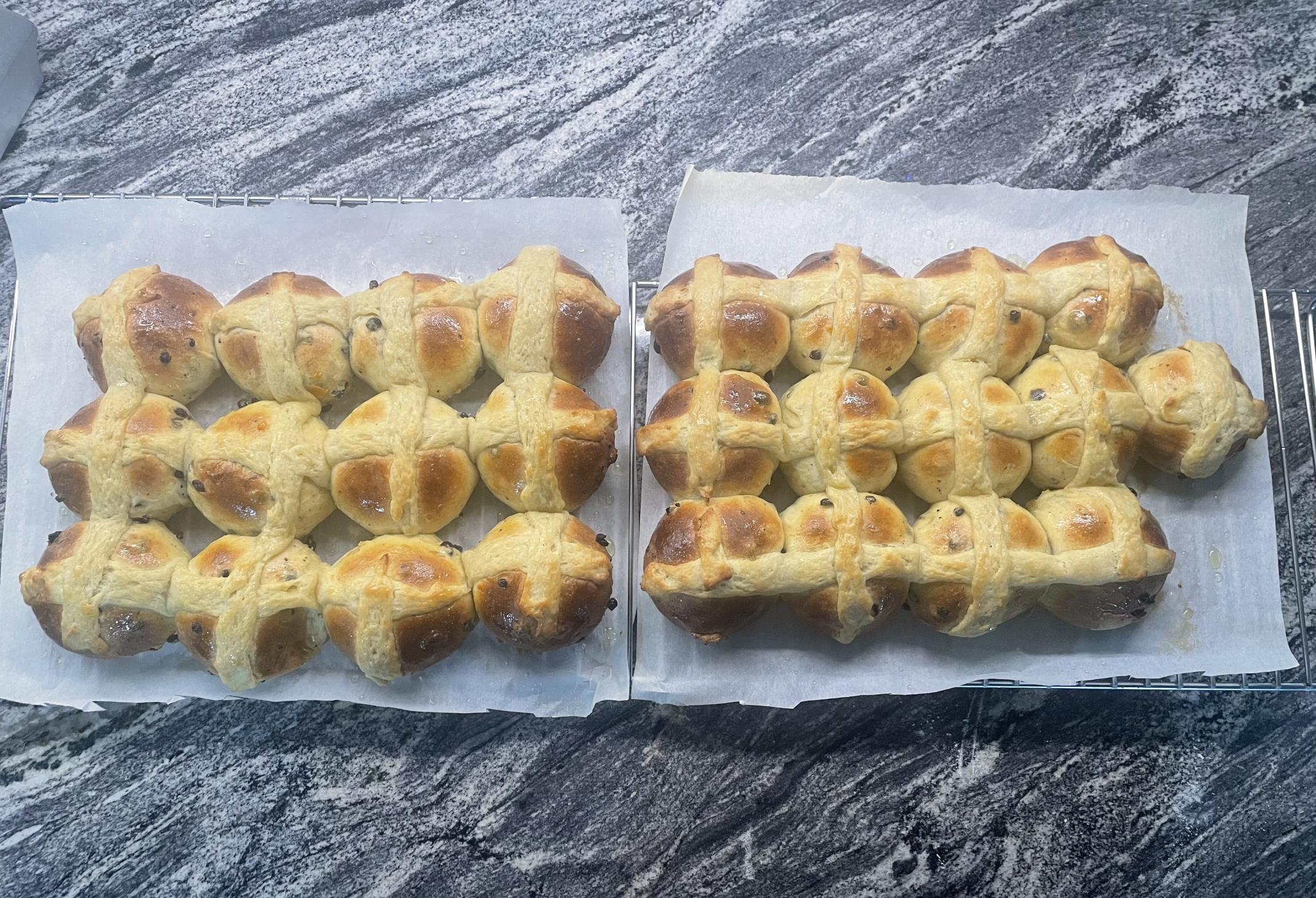
I told my family since they are a lot of work there will be no more command performances so I am looking for a different Easter Bread next year. I am open to suggestions for something different to try.
Don